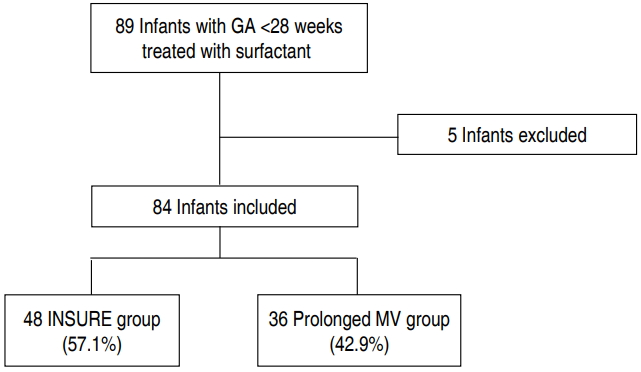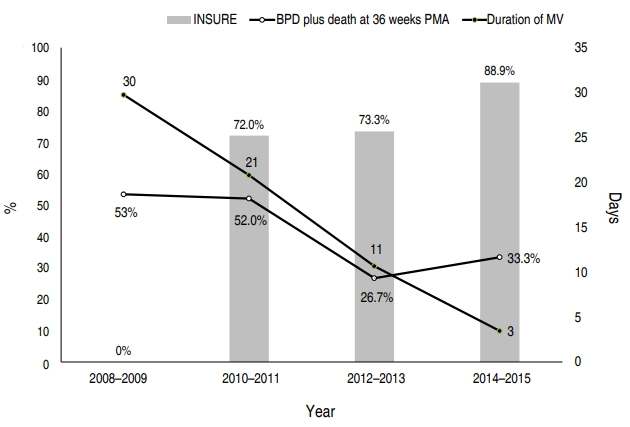1. Rodriguez RJ. Management of respiratory distress syndrome: an update. Respir Care 2003;48:279ŌĆō86.

3. Hayes D Jr, Feola DJ, Murphy BS, Shook LA, Ballard HO. Pathogenesis of bronchopulmonary dysplasia. Respiration 2010;79:425ŌĆō36.


5. Sweet DG, Carnielli V, Greisen G, Hallman M, Ozek E, Plavka R, et al. European Consensus Guidelines on the Management of Respiratory Distress Syndrome - 2016 Update. Neonatology 2017;111:107ŌĆō25.


6. Blennow M, Bohlin K. Surfactant and noninvasive ventilation. Neonatology 2015;107:330ŌĆō6.


9. Verder H, Robertson B, Greisen G, Ebbesen F, Albertsen P, Lundstr├Ėm K, et al. Surfactant therapy and nasal continuous positive airway pressure for newborns with respiratory distress syndrome. Danish-Swedish Multicenter Study Group. N Engl J Med 1994;331:1051ŌĆō5.


10. Stevens TP, Harrington EW, Blennow M, Soll RF. Early surfactant administration with brief ventilation vs. selective surfactant and continued mechanical ventilation for preterm infants with or at risk for respiratory distress syndrome. Cochrane Database Syst Rev 2007;(4): CD003063
12. Dani C, Bertini G, Pezzati M, Cecchi A, Caviglioli C, Rubaltelli FF. Early extubation and nasal continuous positive airway pressure after surfactant treatment for respiratory distress syndrome among preterm infants <30 weeks' gestation. Pediatrics 2004;113:e560ŌĆō3.


14. Sandri F, Plavka R, Ancora G, Simeoni U, Stranak Z, Martinelli S, et al. Prophylactic or early selective surfactant combined with nCPAP in very preterm infants. Pediatrics 2010;125:e1402ŌĆō9.


15. Nakhshab M, Tajbakhsh M, Khani S, Farhadi R. Comparison of the effect of surfactant administration during nasal continuous positive airway pressure with that of nasal continuous positive airway pressure alone on complications of respiratory distress syndrome: a randomized controlled study. Pediatr Neonatol 2015;56:88ŌĆō94.


16. Isayama T, Chai-Adisaksopha C, McDonald SD. Noninvasive ventilation with vs without early surfactant to prevent chronic lung disease in preterm infants: a systematic review and meta-analysis. JAMA Pediatr 2015;169:731ŌĆō9.


19. Dani C, Corsini I, Poggi C. Risk factors for intubation-surfactant-extubation (INSURE) failure and multiple INSURE strategy in preterm infants. Early Hum Dev 2012;88 Suppl 1:S3ŌĆō4.


20. Najafian B, Saburi A, Fakhraei SH, Afjeh A, Eghbal F, Noroozian R. Predicting factors of INSURE failure in low birth-weight neonates with respiratory distress syndrome: a logistic regression model. Iran J Neonatol 2014;5:30ŌĆō4.
21. Doyle DJ. Arterial/alveolar oxygen tension ratio: a critical appraisal. Can Anaesth Soc J 1986;33:471ŌĆō4.


22. Jobe AH, Bancalari E. Bronchopulmonary dysplasia. Am J Respir Crit Care Med 2001;163:1723ŌĆō9.


23. Finer NN, Carlo WA, Duara S, Fanaroff AA, Donovan EF, Wright LL, et al. Delivery room continuous positive airway pressure/positive end-expiratory pressure in extremely low birth weight infants: a feasibility trial. Pediatrics 2004;114:651ŌĆō7.


26. Seong IC, Shin YS, Chang YP. Prophylactic administration of surfactant with nasal continuous positive airway pressure in preterm infants with gestational age less than 30 weeks. J Korean Soc Neonatol 2012;19:253ŌĆō61.

27. Rojas MA, Lozano JM, Rojas MX, Laughon M, Bose CL, Rondon MA, et al. Very early surfactant without mandatory ventilation in premature infants treated with early continuous positive airway pressure: a randomized, controlled trial. Pediatrics 2009;123:137ŌĆō42.


28. Dani C, Corsini I, Bertini G, Fontanelli G, Pratesi S, Rubaltelli FF. The INSURE method in preterm infants of less than 30 weeks' gestation. J Matern Fetal Neonatal Med 2010;23:1024ŌĆō9.


29. G├Čpel W, Kribs A, Ziegler A, Laux R, Hoehn T, Wieg C, et al. Avoidance of mechanical ventilation by surfactant treatment of spontaneously breathing preterm infants (AMV): an open-label, randomised, controlled trial. Lancet 2011;378:1627ŌĆō34.


30. G├Čpel W, Kribs A, H├żrtel C, Avenarius S, Teig N, Groneck P, et al. Less invasive surfactant administration is associated with improved pulmonary outcomes in spontaneously breathing preterm infants. Acta Paediatr 2015;104:241ŌĆō6.


31. Dargaville PA, Ali SKM, Jackson HD, Williams C, De Paoli AG. Impact of minimally invasive surfactant therapy in preterm infants at 29-32 weeks gestation. Neonatology 2018;113:7ŌĆō14.


32. Kanmaz HG, Erdeve O, Canpolat FE, Mutlu B, Dilmen U. Surfactant administration via thin catheter during spontaneous breathing: randomized controlled trial. Pediatrics 2013;131:e502ŌĆō9.


33. More K, Sakhuja P, Shah PS. Minimally invasive surfactant administration in preterm infants: a meta-narrative review. JAMA Pediatr 2014;168:901ŌĆō8.










 PDF Links
PDF Links PubReader
PubReader ePub Link
ePub Link PubMed
PubMed Download Citation
Download Citation


